Affiliate links on Android Authority may earn us a commission. Learn more.
Moto G7 and Moto G7 Power review: Still the best affordable Android phones money can buy
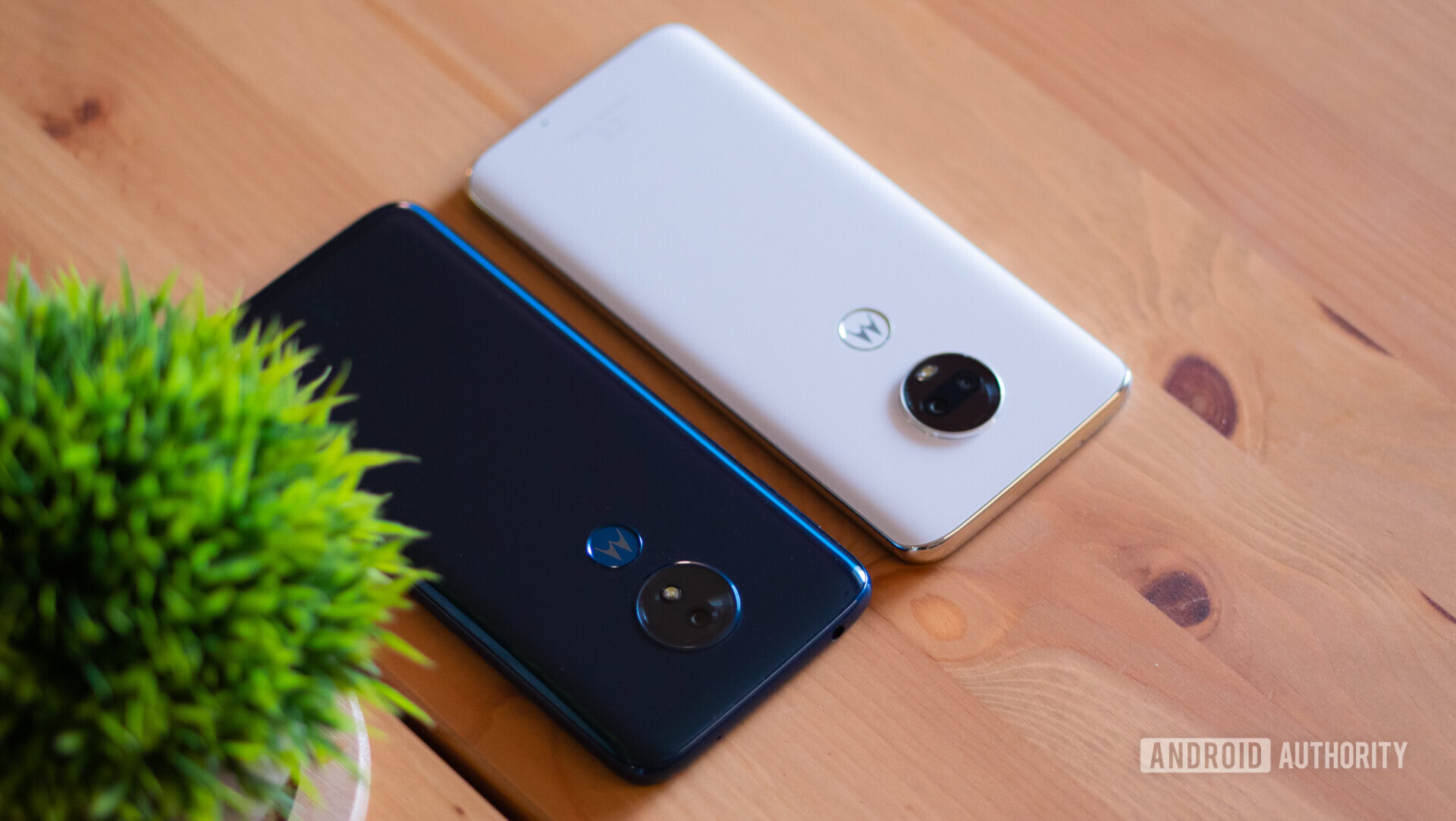
The Moto G series has been Motorola’s bread and butter since its inception back in 2013. At one point, the original Moto G became Motorola’s most popular smartphone. Through each iteration, they’ve continued to have great success by offering reasonable specifications, performance, and features while maintaining an affordable price. The Moto G7 and Moto G7 Power are two of four smartphones in Motorola’s 7th generation Moto G lineup. They’re more powerful and attractive than ever before and yet still won’t break the bank. These are the phones to buy if you want a lot of phone for not a whole lot of money.
This is our Moto G7 and Moto G7 Power review.
Moto G7 and Moto G7 Power review: The Big Picture
These phones are aimed at the budget conscious consumer.
With the Moto G7 and Moto G7 Power, Motorola continues its focus on affordability without making too many sacrifices that would compromise the experience. These phones are aimed at the budget-conscious consumer. The Moto G7 will give you the best that the G7 lineup has to offer. If you’re looking for some serious battery life the Moto G7 Power has you covered, but it has lower specifications overall. As with previous Moto G smartphones, it’s a no-frills approach. You won’t find any extra bells, whistles, or gimmicks. If that’s what you’re looking for, you’ll have to look elsewhere.
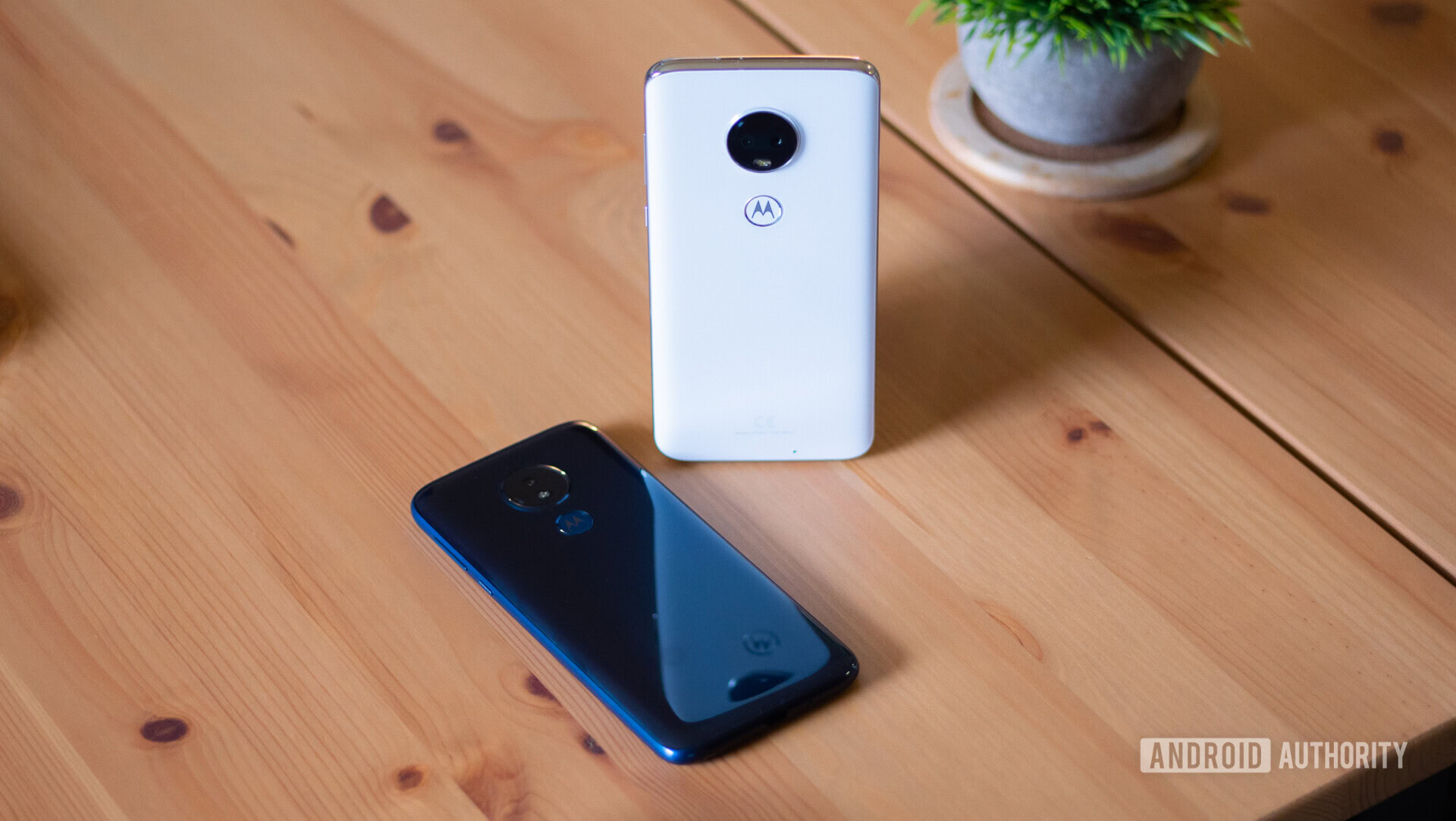
At $299 for the Moto G7 and $249 for the Moto G7 Power, these phones provide excellent value as long as you cull your expectations.
Design
- 157 x 75.3 x 8mm (G7), 159.43 x 76 x 9.3mm (G7 Power)
- 172g (G7) 198g (G7 Power)
- USB-C
- Nano SIM
- P2i nano coating
- Rear fingerprint sensor
- Headphone jack
- microSD slot (up to 512GB)

The Moto G7 and Moto G7 Power feel a lot nicer than their price would lead you to believe.
Despite being budget or mid-range, Motorola has done an excellent job of keeping the Moto G line up to date with current market trends. It all starts with the design. The Moto G7 and Moto G7 Power feature glass bodies and metal frames. This is fairly common among phones that are three to four times the Moto G7 and Moto G7 Power’s price tags, but not always on the lower end. The Moto G7 and Moto G7 power feel a lot nicer than their price would lead you to believe. They’re comfortable to hold and build quality is excellent. They’re also fairly easy on the eyes even if the overall design isn’t particularly striking.
The Moto G7 Power is the chunkier of the two phones in all dimensions, but it’s the added thickness that’s most noticeable. This is due to the G7 Power housing a much larger battery. The phone still looks great, but the Moto G7 proper is the sleeker of the two in terms of look and feel.
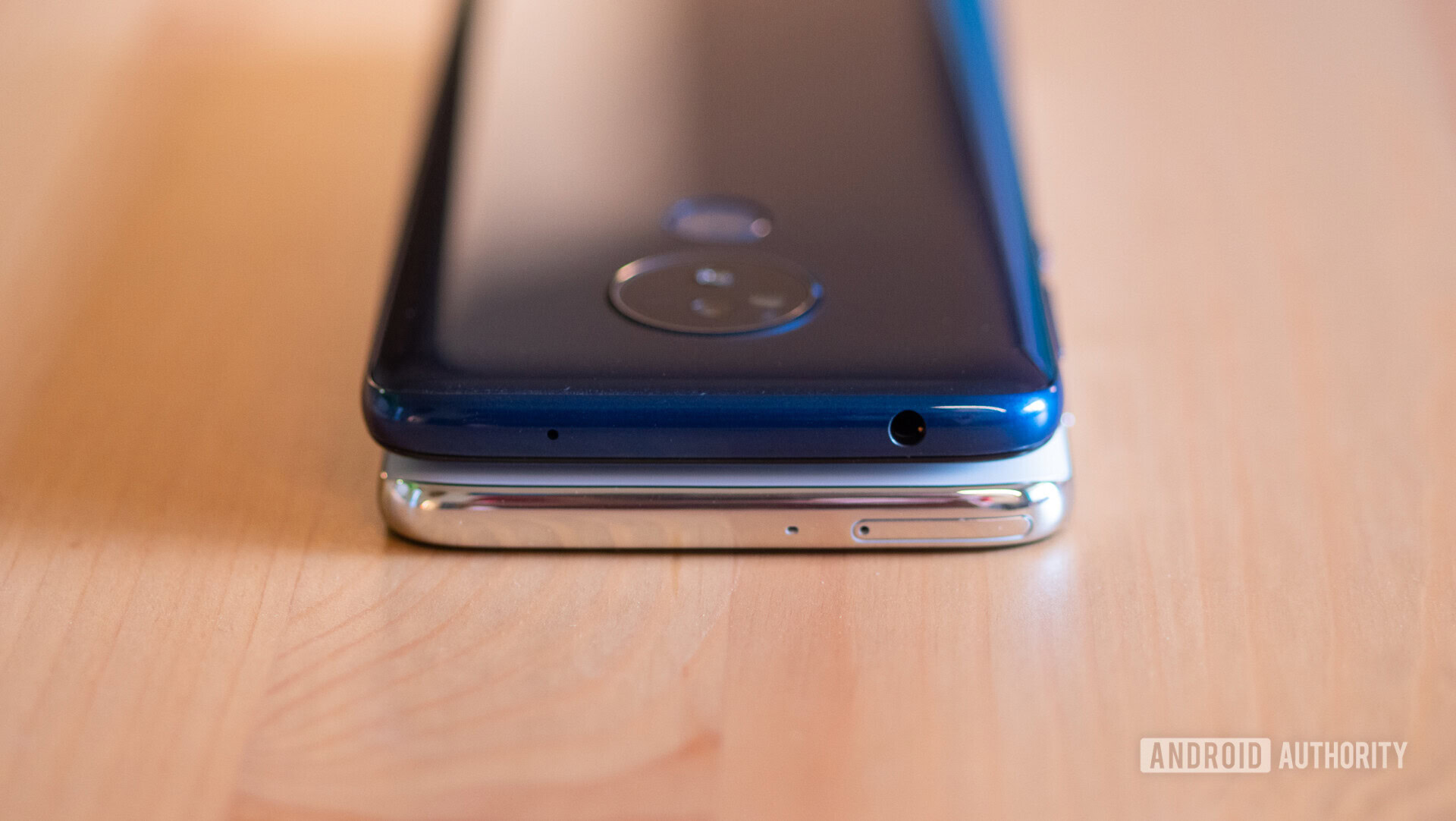
Hardware features between the two are almost identical. They both feature USB-C, fingerprint sensors, expandable storage, single speakers, and a headphone jack. The only difference is the placement of some of these ports. The Moto G7 has its headphone jack and a dedicated speaker on the bottom, while the Moto G7 Power has the headphone jack up top with the speaker integrated into the earpiece.
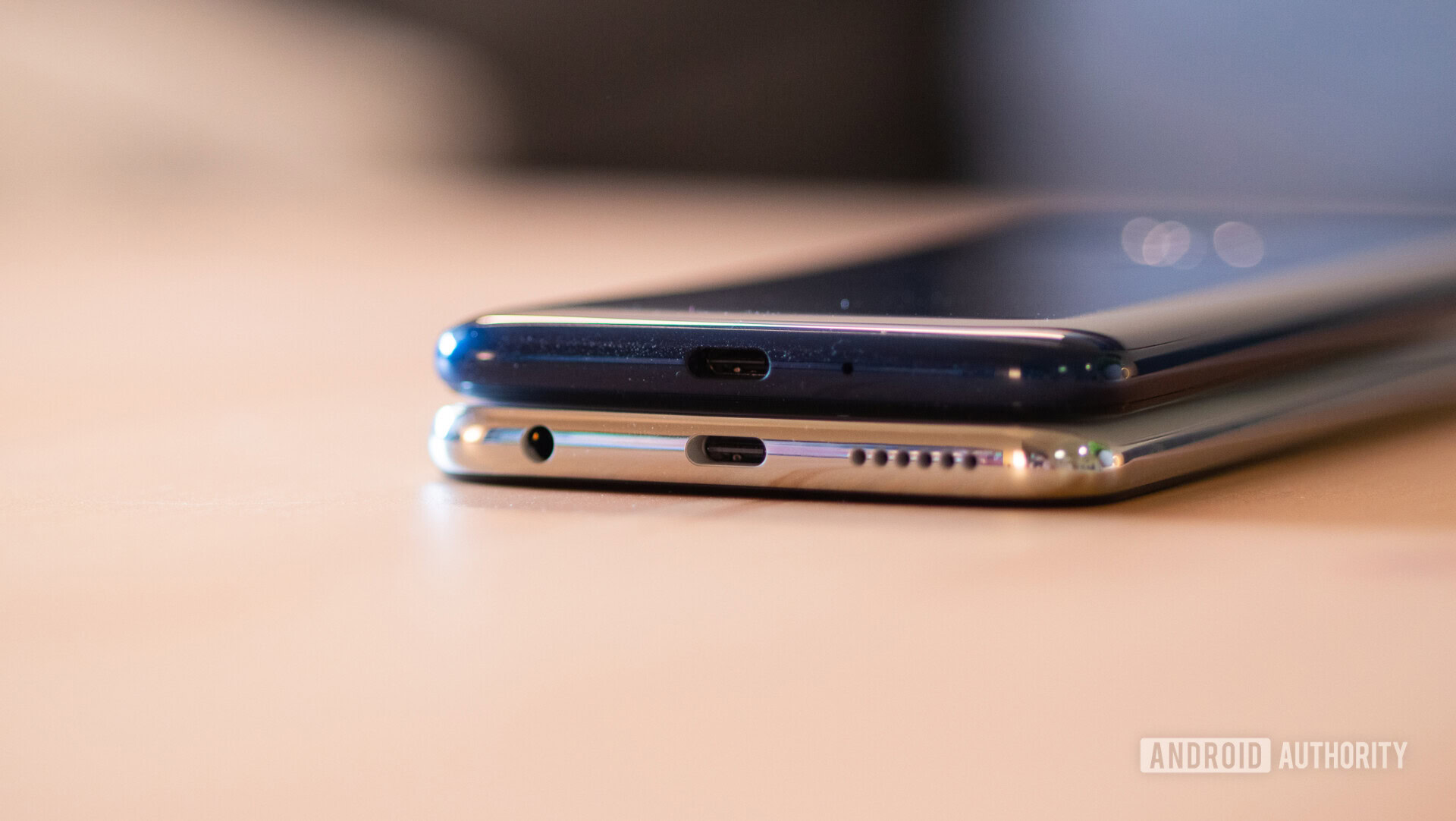
The fingerprint sensors are located on the rear glass panel denoted by the Motorola logo. This is where I’ve always thought Motorola should put the fingerprint sensor, but it wasn’t until last year that it started doing this. As expected, the fingerprint sensors were fast and accurate and the setup process was quick and easy.
In order for Motorola to hit the G7 series’ lower price points, some sacrifices had to be made. One of those sacrifices is the lack of IP certification. This means neither phone is officially water resistant. They do, however, carry a “nano coating” that Motorola typically puts on all of their phones. Motorola says this coating provides splash resistance. This should protect you just fine if you’re using the phones out in the rain, but don’t go swimming with it.
Another feature that’s missing is NFC. This means no mobile payments such as Google Pay or transferring content via Android Beam. NFC seems to come and go on Moto G devices. Some generations have it and some don’t. Motorola told us the G7 lacks NFC purely for cost considerations. It’s not a big deal to me as I rarely take advantage of it, but if you frequently use mobile payments you’re simply out of luck this year.
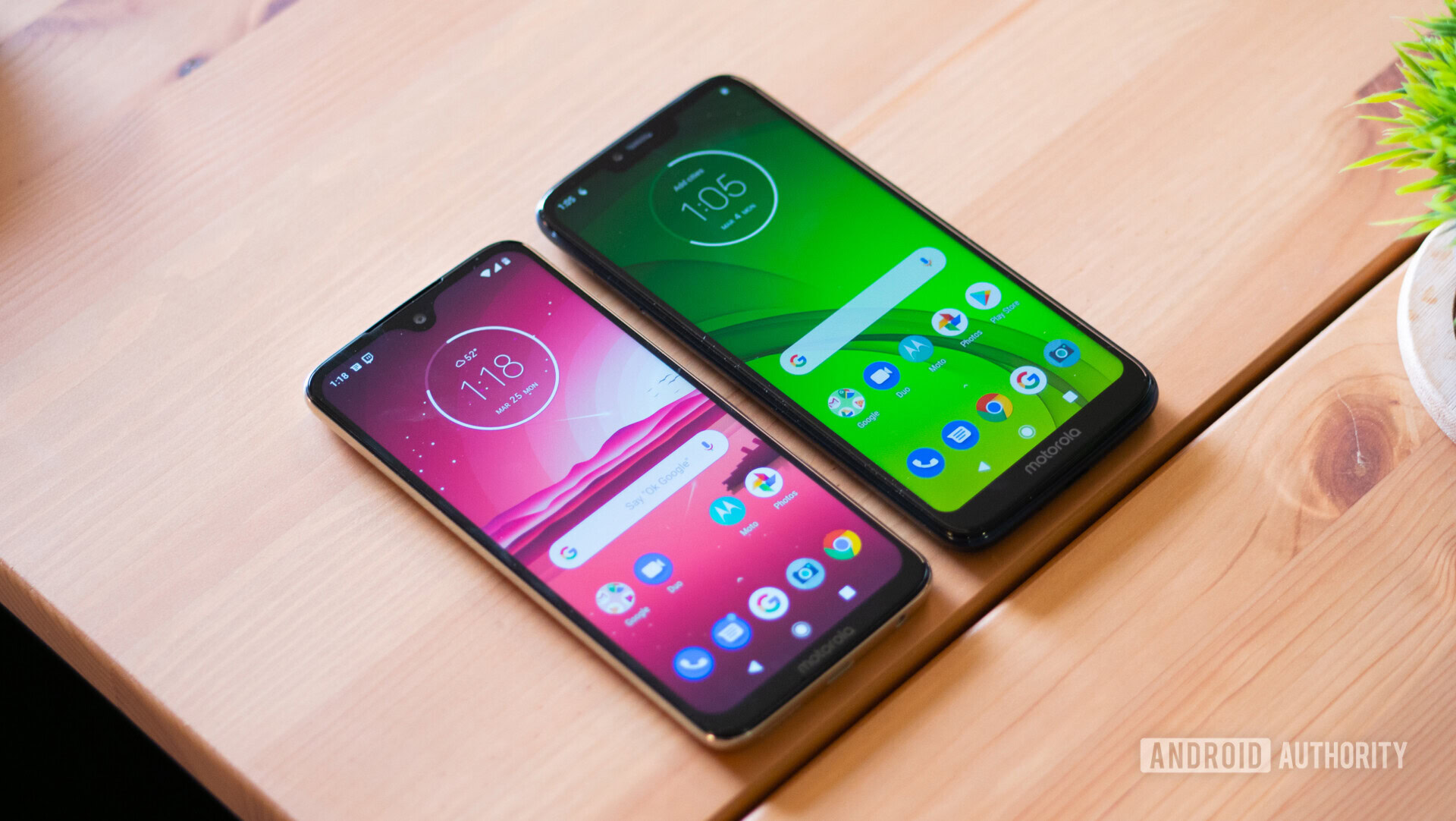
Display
- 6.2-inch LTPS LCD, 19:9
- Full HD+ (G7), HD+ (G7 Power)
- Gorilla Glass 3
- Notch
To keep up with the times, the Moto G7 and G7 Power have somewhat bezel-less displays. They even come with notches. Both displays are identical in size and use the same LCD technology, but the similarities end there. The Moto G7 has a much sharper FHD+ (2,270 x 1,080) resolution while the G7 Power is only HD+ (1,520 x 720). If you aren’t looking closely you might not spot the difference, but to pixel peepers like myself, the G7 Power’s display just isn’t as crisp. It’s fairly easy to spot jagged edges, especially among smaller elements such as app icons and text.
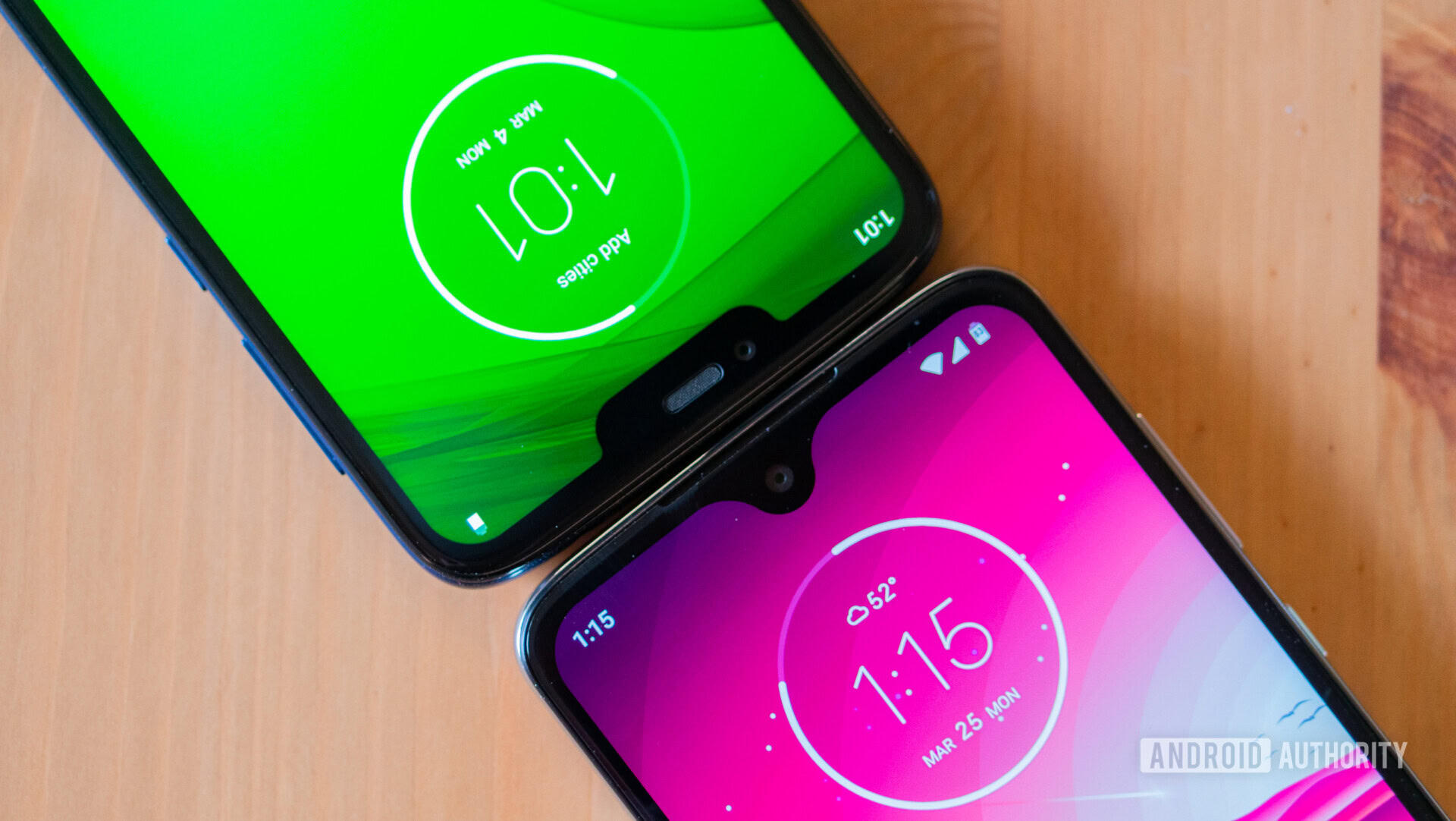
The notches are also not the same. The G7 uses a waterdrop style notch while the G7 Power has the more typical style notch. This is due to the placement of the earpiece: The G7 Power incorporates it into the notch, whereas the G7 pushes the earpiece to the outer bezel. From an aesthetics and functionality standpoint, I prefer the waterdrop. It looks nicer and gives you slightly more screen real estate. Neither phone has particularly small bezels, but the Moto G7’s are slightly thinner.
The quality of the displays won’t knock your socks off but they are perfectly serviceable. Colors look good and so do viewing angles. My only issue with both of these displays is the brightness. They look fine indoors but out in direct sunlight they’re almost impossible to see even at max brightness. Lack of brightness aside, I have no complaints.
Performance
- Qualcomm Snapdragon 632
- 1.8GHz octa-core
- 4GB RAM (G7), 3GB RAM (G7 Power)
- 64GB storage (G7), 32 GB storage (G7 Power)
No matter which phone you decide on you’ll get the same mid-tier Snapdragon processor. The Moto G7 does, however, edge out the Moto G7 Power with an extra gigabyte of RAM and double the storage. This means you’ll get a slightly better multitasking experience and be able to store more media on the phone before it starts to bog down.
In regular everyday use, both phones felt the same and performed just fine. The Moto G7 and G7 Power are more than capable enough to handle average tasks like browsing the web, scrolling through social media, launching apps, and watching YouTube in a smooth fashion. There were no issues with lag or crashes. Just don’t expect the most out of these phones when it comes to gaming. Clash Royale, a game that I play quite frequently, was frustrating to play. It lagged fairly often on both the G7 and G7 Power despite not being very graphically demanding.
On benchmarks such as GeekBench, AnTuTu, and 3DMark, the G7, and G7 Power performed roughly the same. The numbers aren’t staggering but par for the course given the specifications.
Battery
- 3,000 mAh (G7), 5,000 mAh (G7 Power)
- 15W TurboPower charging
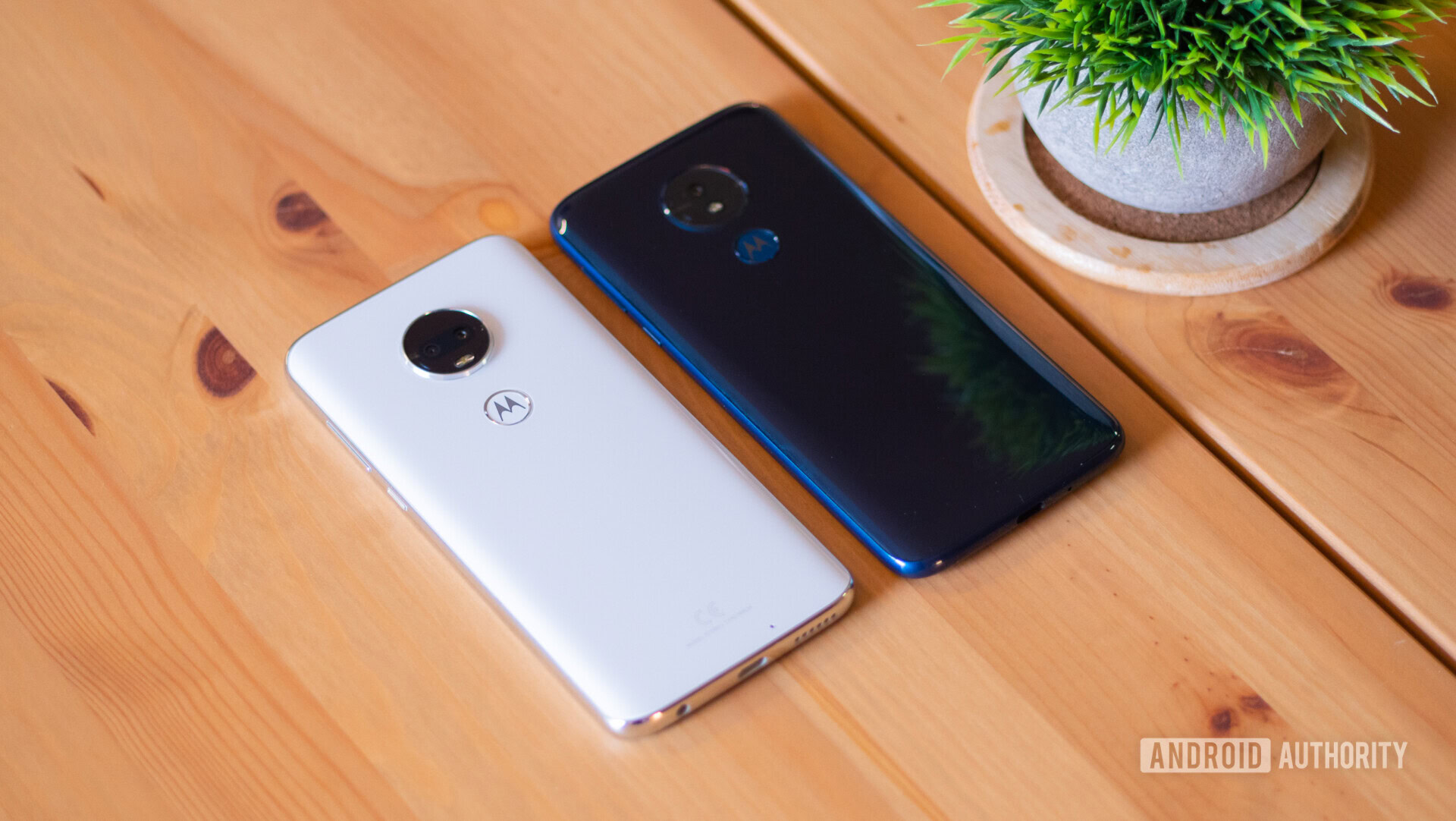
Battery life is one of the Moto G7 and G7 Power’s biggest bright spots. This is especially true for the G7 Power. Motorola claims up to three days of battery life on a single charge. That may sound like a bold claim but isn’t too far-fetched given the generously large battery, lower resolution display, and less power-hungry processor. I haven’t quite gotten close to the three-day mark, but the G7 Power does get me through two full days very easily. That’s still extremely impressive. Screen-on time reached a staggering 10 hours and I’d often go to bed with well over 50% left in the tank. I’ve tried to kill this phone in a single day with hours of gaming and YouTubing but never managed to do so. This phone just doesn’t die.
The Moto G7 won’t give you quite as impressive numbers but battery life is still great. I got anywhere between five to six hours of screen-on time on a daily basis. This is more than enough to comfortably make it to the late night hours on any given day. If you don’t consume quite as much media on your smartphone as I do, you’ll probably eke out even more battery life.
Camera
Rear cameras:
- 12MP f/1.8 (G7), 12MP f/2.0 (G7 Power)
- 5MP depth sensor (G7 only)
- Pixel size 1.25 microns
- LED flash
Front camera:
- 8MP sensor f/2.2
- Pixel size 1.12 microns
If you’re expecting the cameras on the Moto G7 and Moto G7 Power to stack up to smartphone cameras that are double or triple the price then you’ll be sorely disappointed. The cameras are fine for how much these phones cost. Provided you’re in desirable lighting conditions, the images are good enough to share on social media without feeling embarrassed.
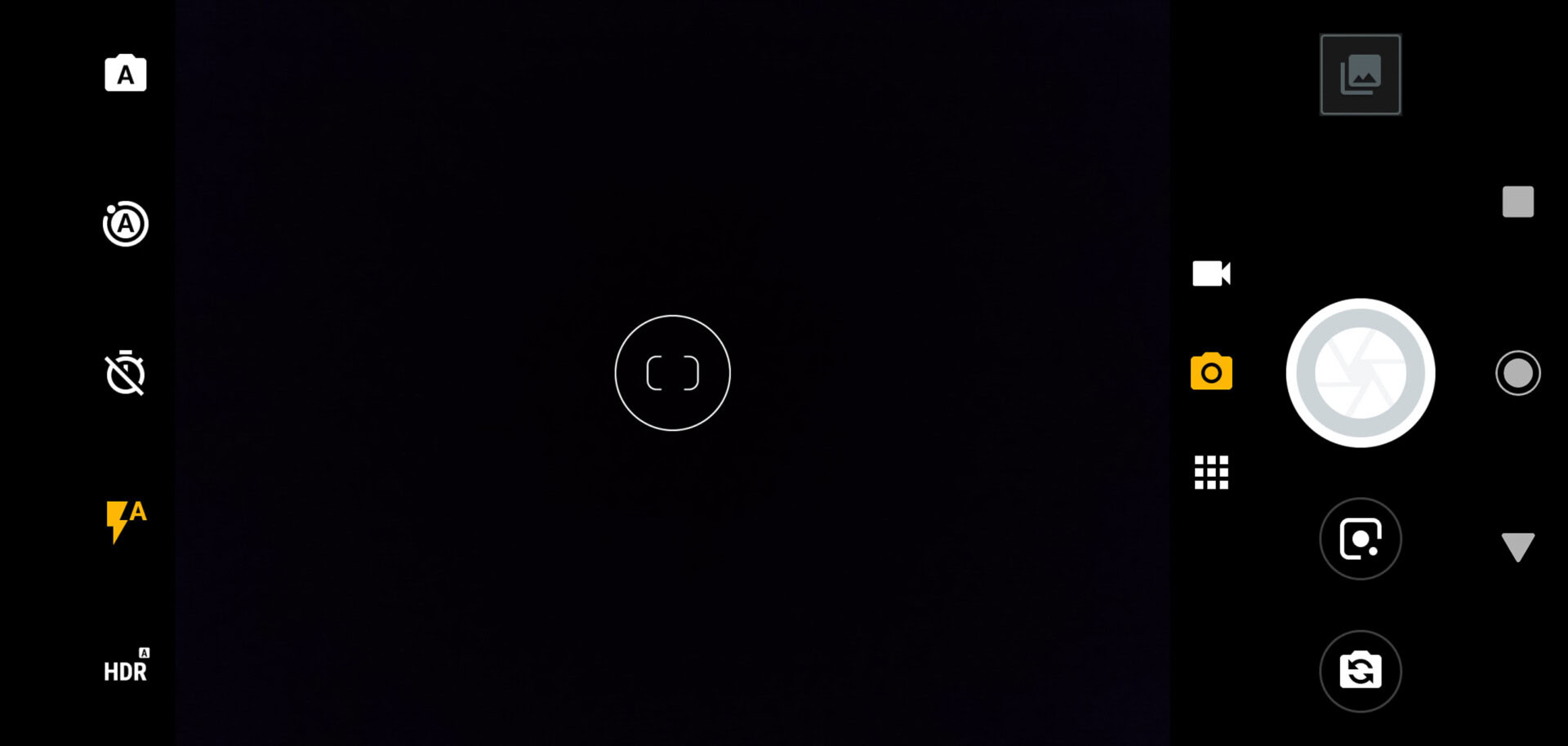
Motorola's camera app doesn't offer too many exciting features, but its simplistic nature makes it easy to use.
Motorola’s camera app doesn’t offer too many exciting features but its simplistic nature makes it easy to use. Switching between photo and video mode is as simple as swiping left or right on the viewfinder. Swiping all the way to the left reveals all of the cameras shooting modes. There isn’t a ton to pick from. You have options such as panorama, portrait, cinemagraph, slow-motion video, time-lapse, and the ability to broadcast live direct to YouTube. There’s also a manual mode for more granular control and Google Lens integration.
The Moto G7 has the better camera of the two. Although they both have 12MP cameras, they aren’t identical sensors. The G7 has a wider f/1.8 aperture when compared to the G7 Power’s f/2.0. The G7 also boasts a depth sensor. A wider aperture means slightly better low light performance and much better-looking portrait mode photos. Having a depth sensor also allows the Moto G7 to refocus and adjust the background blur after the fact. You can’t do this on the G7 Power, as its rear camera is limited to only taking portrait mode photos when it detects a face.
Let’s be real. Neither camera is spectacular in low light. Highlights are severely blown out, details are muddy, and the images are very noisy. In bright conditions or average indoor lighting, you can pull off some good-looking shots with bright colors and detail. Photos from the Moto G7 and Moto G7 Power look fairly similar but you can spot some differences when you look closely. The Moto G7’s photos are brighter and slightly more vibrant in color. This tends to make the G7’s photos look much more appealing.
Both the Moto G7 and Moto G7 Power have the same selfie camera so you can expect identical results. Selfies aren’t quite as sharp as I’d like and colors seem a little flat. The auto beauty mode (on by default) is also a little too aggressive with skin softening for my tastes so I ended up turning this off.
We have a gallery of full-resolution photos taken on the Moto G7 and Moto G7 Power here.
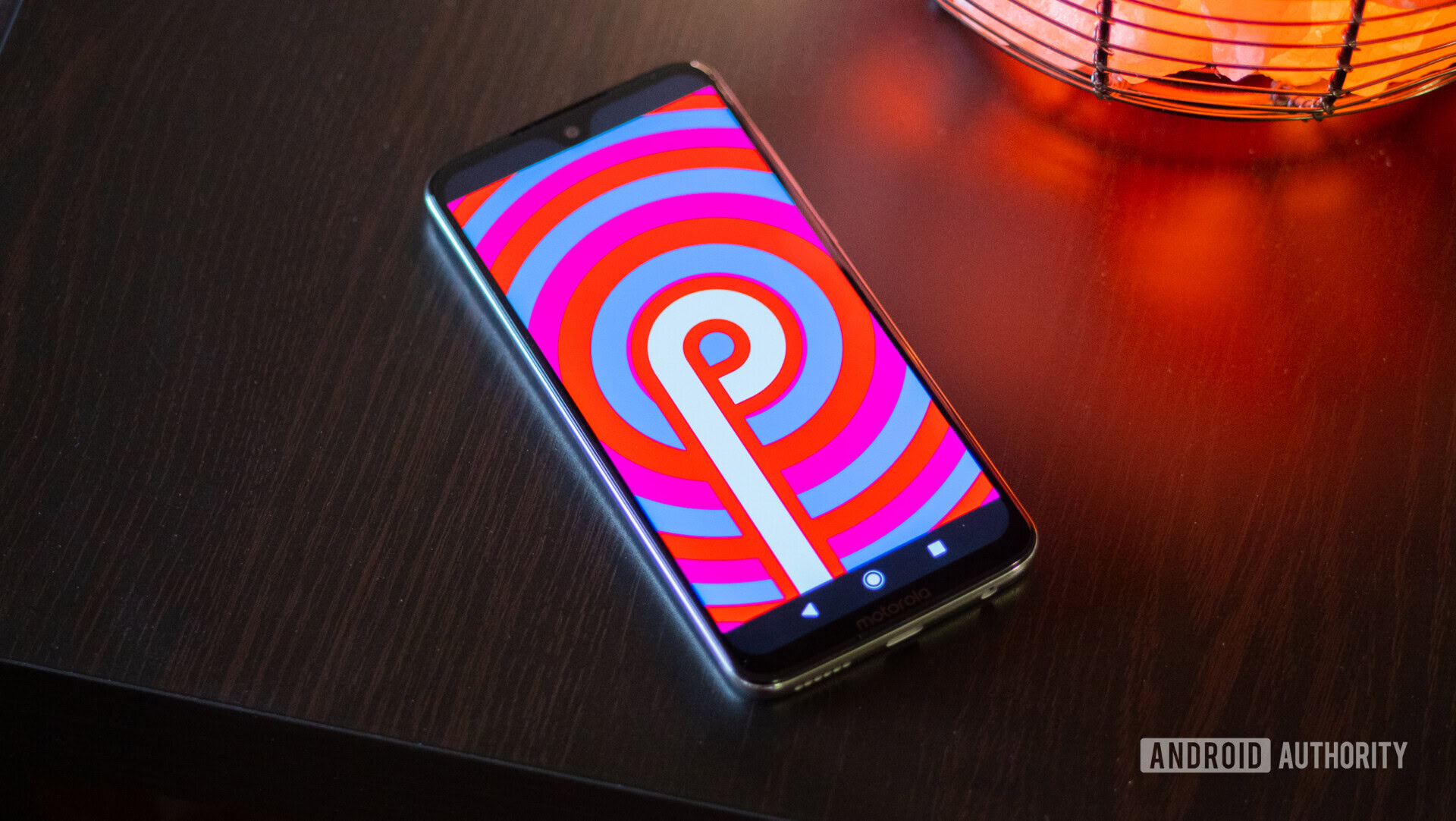
Software
- Android 9.0 Pie
- Moto Actions, Display, Voice
Motorola handles a few things better than stock Android Pie.
If there’s one thing that I’ve always loved about Motorola, it’s the software experience. Ever since the original Moto X, Motorola has gone with a bare-bones approach. The software on the Moto G7 and G7 Power is about as close as it can get to a stock build of Android 9 Pie outside of a Pixel device. It’s clean, fast, and there’s next to no bloatware to bog down the experience.
Motorola handles a few things better than stock Android Pie. The app drawer on Motorola’s launcher can be accessed with a simple short swipe instead of an annoyingly long swipe upwards. Motorola’s gesture navigation is also much more intuitive than Google’s implementation. The software defaults to standard on-screen buttons if gesture navigation isn’t quite your thing.
All of Motorola’s usual software enhancements, such as Moto Actions, Moto Display, and Moto Voice, are all neatly placed inside the Moto app. This makes it easy to find and keeps the software from feeling cluttered. There are a ton of gestures for controlling basic actions including Motorola’s signature double chop for flashlight and wrist twist to launch the camera. Many of the gestures are super useful and I appreciate that Motorola has expanded on these gestures over the years.
Both the Moto G7 and G7 Power will most likely get a couple of major software updates during their lifetime, though it’s hard to predict when. Ever since the Lenovo acquisition, Motorola hasn’t had the best track record when it comes to speedy updates. Motorola’s first phone to receive Android Pie, the Motorola One, took 114 days. This ranks them as the eighth fastest OEM to start rolling out Pie on our list. The next major version of Android, Android Q, is still several months away from its official release, so we’ll have to wait and see how quick Motorola is to react. If history is any indication, you’ll have to wait a good while.
Audio
- Single speaker
- 3.5mm headphone jack
There isn’t much to say about the audio experience. You won’t find anything that makes it special. Neither phone has stereo speakers, but at this price you shouldn’t expect them to. Both phones come with a single firing speaker. The Moto G7’s speaker is on the bottom and the Moto G7 Power’s is integrated into the earpiece. Neither one sounds spectacular, though they get loud enough to do the job when watching a quick YouTube video. Whichever device you go for, you’re going to have a lopsided listening experience.
Specifications
| Motorola Moto G7 | Motorola Moto G7 Power | |
|---|---|---|
Display | Motorola Moto G7 6.2-inch LTPS LCD 2270 x 1080 resolution (Full HD+) 403ppi 19:9 aspect ratio | Motorola Moto G7 Power 6.2-inch LTPS LCD 1520 x 720 resolution (HD+) 19:9 aspect ratio |
SoC | Motorola Moto G7 Qualcomm Snapdragon 632 1.8GHz octa-core | Motorola Moto G7 Power Qualcomm Snapdragon 632 1.8GHz octa-core |
GPU | Motorola Moto G7 Adreno 506 | Motorola Moto G7 Power Adreno 506 |
RAM | Motorola Moto G7 4GB | Motorola Moto G7 Power 3GB |
Storage | Motorola Moto G7 64GB microSD card support up to 512GB | Motorola Moto G7 Power 32GB microSD card support up to 512GB |
Cameras | Motorola Moto G7 Rear cameras: 12MP main sensor, ƒ1.8 aperture, 1.25μm pixels 5MP depth sensor, LED flash, PDAF, digital zoom (up to 8x), electronic video stabilization Video: 2160p/4K @ 30fps, 1080p @ 60/30fps, 720p @ 120/30fps Front camera: 8MP sensor, 1.12μm pixels, screen flash, auto HDR | Motorola Moto G7 Power Rear camera: 12MP sensor, ƒ2.0 aperture, 1.25μm pixels, PDAF, LED flash Video: 1080p @ 30fps, 720p @ 30fps, 480p @ 30fps Front camera: 8MP sensor, ƒ2.2 aperture, 1.12μm pixels |
Battery | Motorola Moto G7 3,000mAh Non-removable 15W TurboPower charging | Motorola Moto G7 Power 5,000mAh Non-removable TurboPower |
IP rating | Motorola Moto G7 Water-repellent design with P2i nano coating No official IP rating | Motorola Moto G7 Power Water-repellent design with P2i nano coating No official IP rating |
Sensors | Motorola Moto G7 Fingerprint sensor Proximity Accelerometer Ambient light Sensor hub Gyroscope Ultrasonic Magnetometer (e-Compass) | Motorola Moto G7 Power Fingerprint sensor Proximity Accelerometer Ambient light Sensor hub Gyroscope Magnetometer (e-Compass) |
Network | Motorola Moto G7 Carrier Aggregation, 4G LTE (DL Cat 7/ UL Cat 6), CDMA / EVDO Rev A, UMTS / HSPA+, GSM / EDGE 2G: GSM band 2/3/5/8 CDMA BC0/BC1/BC10 3G: WCDMA band 1/2/4/5/8 4G: FDD LTE band 1/2/3/4/5/7/8/12 /13/17/20/25/26/66 4G: TDD LTE band 38/40/41/41 HPUE | Motorola Moto G7 Power Carrier Aggregation, 4G LTE (DL Cat 7/ UL Cat 6), CDMA / EVDO Rev A, UMTS / HSPA+, GSM / EDGE 2G: GSM band 2/3/5/8 CDMA BC0/BC1/BC10 3G: WCDMA band 1/2/4/5/8 4G: FDD LTE band 1/2/3/4/5/7/8/12 /13/14/17/20/25 /26/29/30/66/71 4G: TDD LTE band 38/39/40/41/41 HPUE |
Connectivity | Motorola Moto G7 USB-C port (USB 2.0) 3.5mm headphone jack FM radio Bluetooth 4.2 LE, aptX Wi-Fi 802.11 a/b/g/n, 2.4GHz + 5GHz, Wi-Fi hotspot GPS, A-GPS, GLONASS, Galileo | Motorola Moto G7 Power Type C (USB 2.0), OTG 3.5mm headphone jack FM radio Bluetooth 4.2 LE Wi-Fi 802.11 a/b/g/n, 2.4GHz + 5GHz, Wi-Fi hotspot GPS, AGPS, LTEPP, SUPL, GLONASS |
NFC | Motorola Moto G7 No | Motorola Moto G7 Power No |
SIM | Motorola Moto G7 Single nano-SIM | Motorola Moto G7 Power Single nano-SIM |
Software | Motorola Moto G7 Android 9 Pie | Motorola Moto G7 Power Android 9 Pie |
Dimensions and weight | Motorola Moto G7 157 x 75.3 x 8mm 172g | Motorola Moto G7 Power 159.43 x 76 x 9.3mm 198g |
Colors | Motorola Moto G7 Ceramic Black, Clear White | Motorola Moto G7 Power Marine Blue |
Moto G7 and Moto G7 Power: The verdict
The Moto G line has been leading the pack in the budget space for quite some time. Motorola continues to deliver a quality experience at a low price point with few compromises. Even in 2019, there aren’t many competitors that give it a run for its money. The Android One Nokia 6.1, HUAWEI P20 Lite, and HONOR 8X are notable alternatives, but some of these phones don’t work across all major U.S. carriers. The Moto G7 and Moto G7 Power are compatible with AT&T, Google Fi, Sprint, T-Mobile, and Verizon Wireless in the U.S.
Both smartphones are fantastic options if you want a solid all-around experience without dropping a ton of cash. You’re getting a modern design, fast software, and excellent battery life. Camera quality could be better but you can’t complain too much about sub-$300 smartphones. If you want extra bells and whistles such as IP certification, a better camera, NFC, or wireless charging, these phones aren’t for you. You’ll have to seek more expensive alternatives like the Galaxy S10 for those kinds of features.
I would recommend the Moto G7 and Moto G7 Power to anyone who wants modern features without necessarily requiring the latest specs.
Leave us your thoughts on the Moto G7 and G7 Power in the comments!